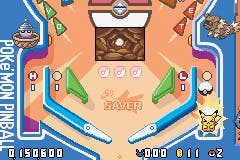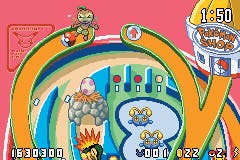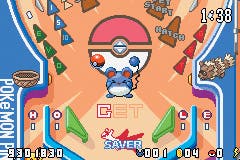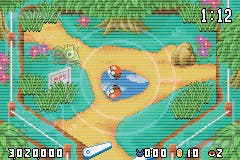Pokemon Pinball: Ruby & Sapphire review
Gotta flipper them all!
I like to believe I was a pinball wizard in my town. Every Friday night, there I was on the Addams Family machine down my local, pint under the table, cheering throng behind me and adoring lady friends hanging from every limb. But, actually, no. I am terrible at pinball and always have been, but this is Pokemon Pinball. I mean how hard can it be? I felt right at home.
Red and Blue

It would've been easy for Nintendo to craft a couple of generic pinball tables, throw in the Pokemon imagery and pop the cart in a box. In fact, that's exactly what I was expecting. More fool me, then, when Pokemon Pinball turned out to be one of the most arresting pinball games I'd played in a long time. The key to its greatness lies in the fact that racking up millions of points by bumping bumpers and shooting your ball up ramps isn't the only road to success - it won't even get you on the road to completion. Because while Pokemon Pinball initially presents a couple of tables and a ball and lets you get on with it, you'll begin to discover that it has hidden depths. Well okay, not hidden, just not immediately apparent depths.
These not immediately apparent depths revolve around the core premise of Pokemon which is, of course, to catch 'em all. And never before have I ever wanted to catch 'em all quite so much as I have when playing Pokemon Pinball. Not even when I've been playing Pokemon, to be honest.
The best thing is that it works really simply. Shooting a combination of ramps and a target (Sharpedo on the Ruby table and Wailmer on Sapphire) will activate Catch 'Em Mode, which presents an icon of the Pokemon you'll be able to catch. Then you have to smash a few bumpers to get the little chap to appear, and then finally bonk him on the head a couple of times with the ball to capture him. One down, 199 to go.
Evolution

You can even evolve Pokemon in order to boost your collection (which are entered into a universal Pokedex each time you capture a critter) via other ramp/target combos. Another alternative is to capture egg-hatched Pokemon by activating an incubator - passing your ball through it multiple times - or bashing Cynquadil on the head until he incubates the egg. Once it hatches, the monster will run about the table and if you can knock your ball against him a few times before he manages to escape, you'll earn yourself another monster.
Finally, activating Travel Mode will allow you to move to another location. The actual table itself doesn't change, but moving between Forest, Plains, Ocean and Cave (as well as each table's exclusive locations) will mean that different Pokemon appear for capture. When capturing Pokemon instead of racking up millions of points becomes your primary concern - and it will - you'll find yourself developing strategies and starting up games just to see if you can find specific Pokemon. Hell, this isn't pinball, this is an adventure.
When you do decide to try and get your name up on the high score table, a concerted effort will see you bagging ridiculous scores in the hundreds of millions. At the last count, my Sapphire table score was well in excess of 400 million, and that's the current game in progress, thanks to the handy save function which lets me switch off and continue the game whenever I feel like it.
Make millions

Frankly, even though I'm terrible at pinball, getting into the upper echelons of the high score table seemed just a tad too easy thanks to a number of factors. Firstly, you can use coins collected during play to buy ball saves from each table's Pokemon Mart [how apt -Ed]. Then there's a little Pikachu sitting in the gutter, and if you're quick enough to send him to the right side and intercept the ball then he'll literally attack it back into play. You can also upgrade your ball to multiply scores by passing it through the three gates at the top of the table, with each upgrade increasing the multiplier.
Further adding to the scoring orgy are the bonus rounds, which form simple tables in their own right. You activate the bonus rounds on the main table and are transported to the bonus table for a limited time. The round you play depends on location and the flavour of table you're playing on, and sometimes you'll be put up against some kind of boss character.
One particularly memorable bonus round set in a graveyard requires the player to hit ghosts for points, and if enough are hit then a huge ball-grabbing mummy turns up for a fight. Another presents a seemingly empty forest scene, until you shoot a pair of goggles with the ball, which temporarily reveals the location of a cloaked monster with a screen overlay. There are plenty more to discover, and the creativity on show is pretty surprising for what I originally assumed was "just" a pinball game.
Hi-scores

The only real issue I have to raise with the game is that the two tables are worryingly similar to each other, though this is offset quite well by the bonus modes, and that, well, there are only two of them. The tables are nicely designed and deceptively simplistic for all their hidden bonuses and point-boosting features, and what the Pokemon that adorn them lack in animation they more than make up for by being characteristically adorable.
The issue of longevity also raises its head, much in the same way that it does with Pokemon itself. Only the real hardcore players are going to want to sit for days attempting to pick up every last critter, and I fear that the pinball may be a little simplistic and lack the variety and challenge fans of the genre are going to be after.
That said, Pokemon Pinball is more than the lukewarm cash-in you might expect. The two styles of play - high scoring or Pokemon catching - allow you to explore the tables twice over with different motives, while the immediate accessibility will suit players who are looking for some purely basic pinball fun. Only the most demanding of pinball wizards would be right to turn their nose up at Pokemon Pinball's charming slant on the genre.

